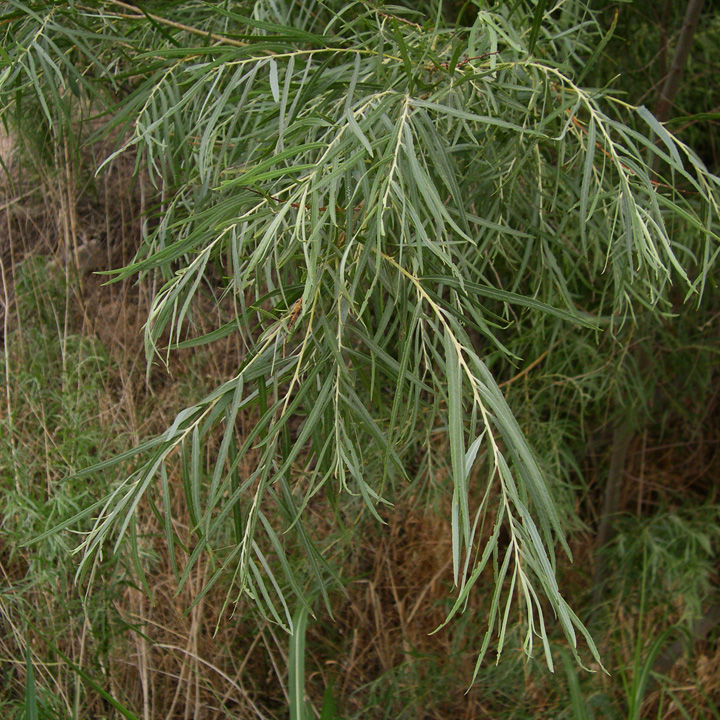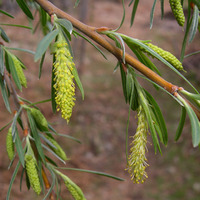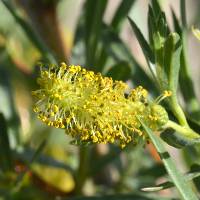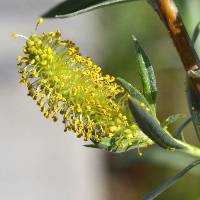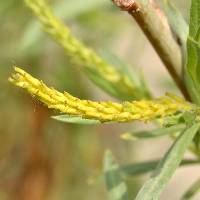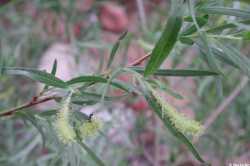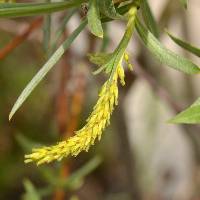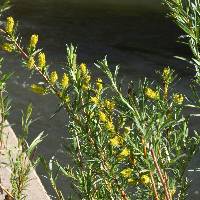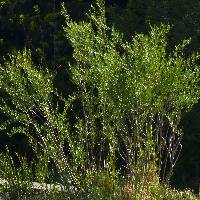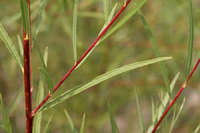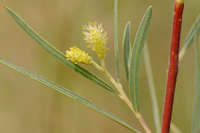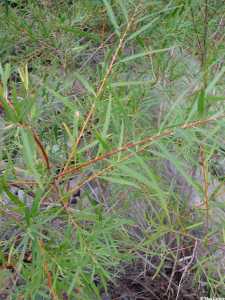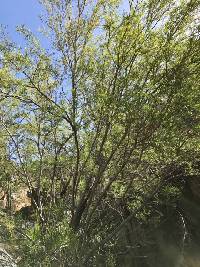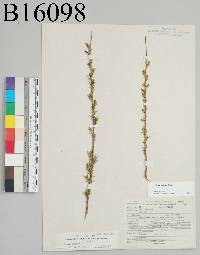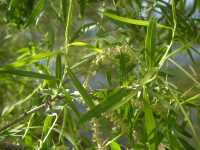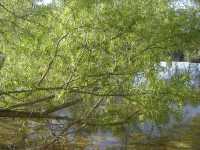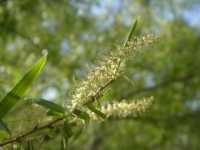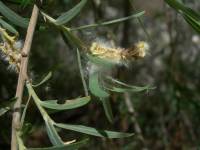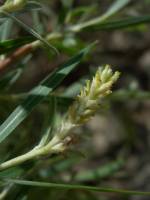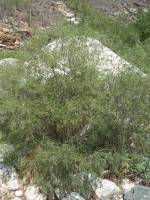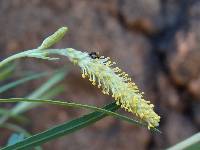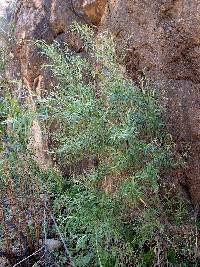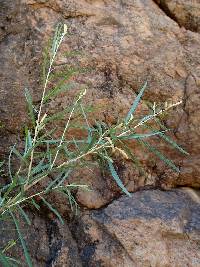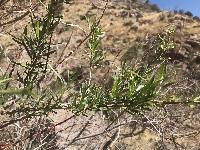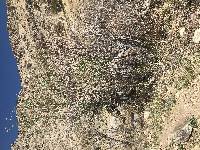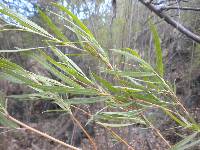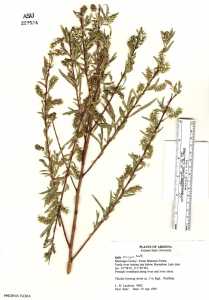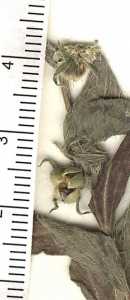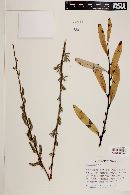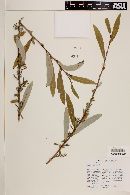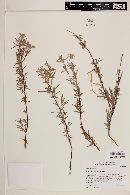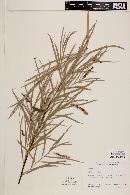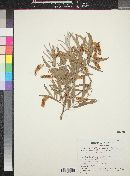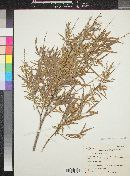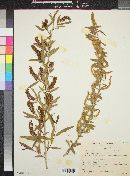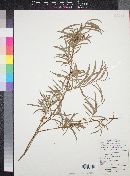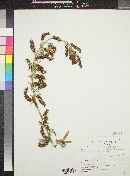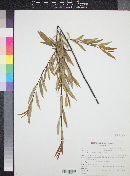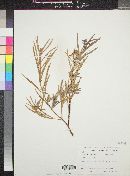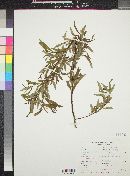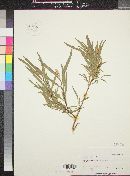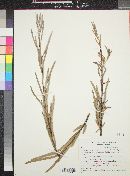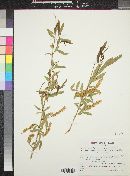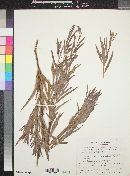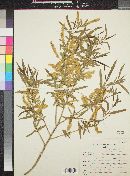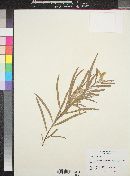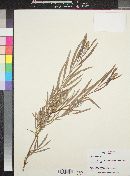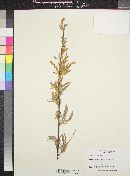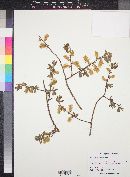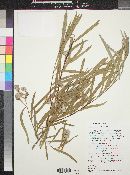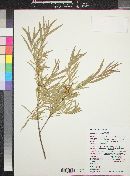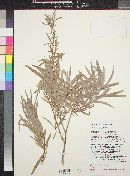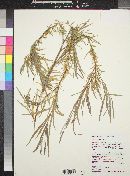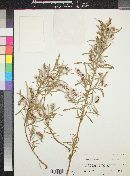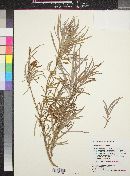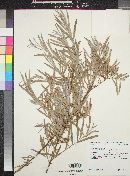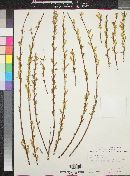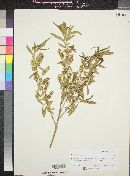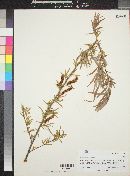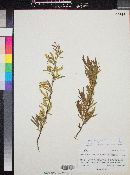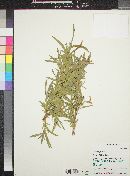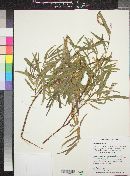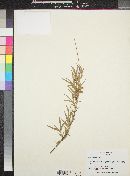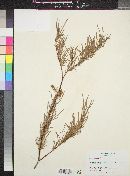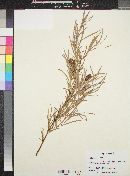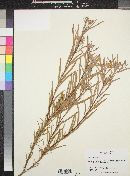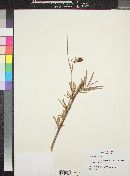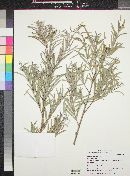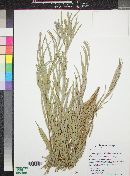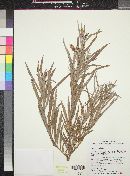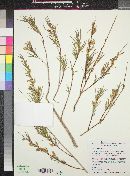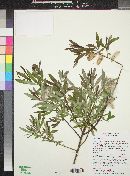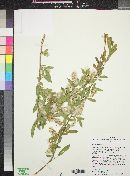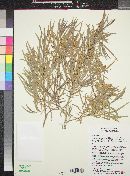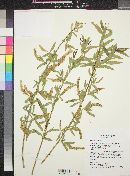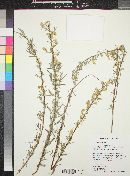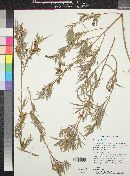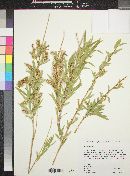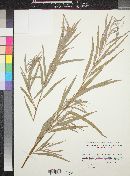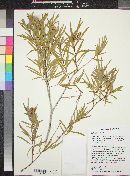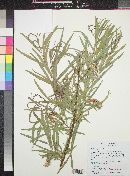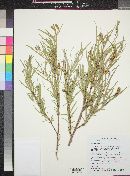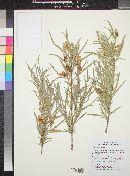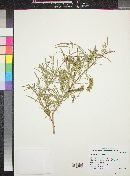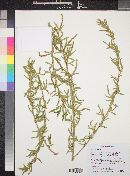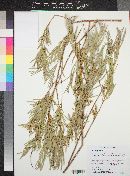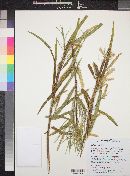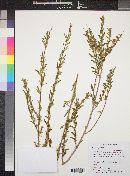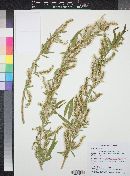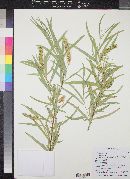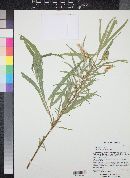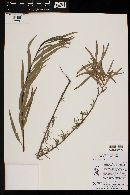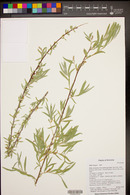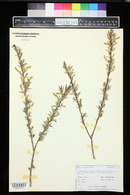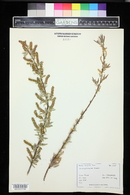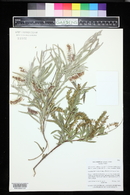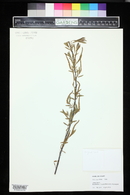Salix exigua
|
|
|
|
Family: Salicaceae
Narrow-Leaf Willow, more...narrowleaf willow, coyote willow, desert willow, Hinds' willow, sandbar willow (es: sauce)
[Salix argophylla Nutt., moreSalix exigua var. angustissima (Anderss.) Reveal & Broome, Salix exigua var. columbiana Dorn, Salix exigua var. luteosericea (Rydb.) Schneid., Salix exigua var. nevadensis (S. Wats.) Schneid., Salix exigua var. parishiana (Rowlee) Jepson, Salix exigua var. stenophylla (Rydb.) Schneid., Salix exigua var. virens Rowlee, Salix fluviatilis var. argophylla (Nutt.) Sarg., Salix hindsiana Benth., Salix hindsiana var. leucodendroides (Rowlee) Ball, Salix hindsiana var. parishiana (Rowlee) Ball, Salix hindsiana var. tenuifolia (Anderss.) Anderss., Salix interior var. angustissima (Anderss.) Dayton, Salix interior var. luteosericea (Rydb.) Schneid., Salix linearifolia Rydb., Salix longifolia var. argophylla (Nutt.) Anderss., Salix longifolia var. exigua (Nutt.) Bebb, Salix longifolia var. opaca Anderss., Salix luteosericea Rydb., Salix macrostachya var. leucodendroides Rowlee, Salix malacophylla Nutt. ex Ball, Salix nevadensis S. Wats., Salix parishiana Rowlee, Salix sessilifolia subsp. hindsiana , Salix sessilifolia var. hindsiana (Benth.) Anderss., Salix sessilifolia var. leucodendroides (Rowlee) Schneid., Salix stenophylla Rydb.] |
Shrubs or trees, 0.5-5(-17) m. Stems: branches gray-brown, red-brown, or yellow-brown, villous, or tomentose to glabrescent; branchlets yellowish, yellow-brown, or red-brown, pubescent or puberulent, tomentose, short- or long-silky villous. Leaves: stipules absent or rudimentary on early ones, foliaceous or rudimentary on late ones; petiole 1-5(-10) mm, pubescent or puberulent, villous, or short-silky adaxially; largest medial blade (sometimes hypostomatous), linear or lorate, (glands marginal), 30-136-143 × 2-14 mm, 6.5-28(-37.5) times as long as wide, base cuneate, margins slightly revolute, entire or remotely spinulose-serrulate, apex acuminate or acute, abaxial surface glaucous (sometimes obscured by hairs), densely long-silky, villous or pilose to glabrescent, hairs appressed or spreading, straight or wavy, adaxial slightly glossy, sparsely or densely long-silky to glabrescent; proximal blade margins entire; juvenile blade yellowish green, densely long-silky-villous abaxially. Catkins: staminate 7-54 × 2-10 mm, flowering branchlet 1.5-56 mm; pistillate loosely to densely flowered, slender or stout, 14.5-70 × 3-12 mm, flowering branchlet 2-55 mm; floral bract 1.2-2.6 mm, apex acute, convex, or rounded, entire or erose, hairs wavy, straight, or crinkled, abaxially hairy throughout or proximally, or glabrate. Staminate flowers: abaxial and adaxial nectaries present and distinct; filaments hairy on proximal 1/2; anthers (sometimes reddish turning yellow). Pistillate flowers: adaxial nectary oblong, ovate, or flask-shaped, relative adaxial nectary/stipe length variable even within same catkin; stipe 0-0.9 mm; ovary obclavate or pyriform, glabrous, pilose, or villous, or sometimes beak hairy, beak bulged below or abruptly tapering to styles; ovules 12-30 per ovary; styles (sometimes distinct), 0-0.5 mm; stigmas flat, abaxially non-papillate with rounded tip, or 2 plump lobes, 0.1-0.5 mm. Capsules 4-8 mm. 2n = 38. Plant: Dioecious shrub or tree; 0.5-6 m tall, clonal by root suckers; branches gray-, red-, to yellow-brown, glabrous or tomentose becoming glabrous; branchlets glabrescent to hairy Leaves: stipules leaflike to absent; petioles glabrous or hairy, 1-9 mm long; proximal leaves on vegetative or flowering branchlets entire or gland-dotted; young leaves long silky; mature blade linear or ligulate, 30-160 mm long, 2-9 mm wide, 10-28(-37.5) times as long as wide, the lower surface glaucous or densely silky to silky-villous, the upper surface shiny, glabrescent or sparsely white villous to long silky, the base cuneate, the margins slightly revolute, remotely spinulose-serrulate or gland-dotted, with 1-5 teeth or glands per cm, the apex acuminate or acute INFLORESCENCE: cylindrical to subspherical catkins; coetaneous or serotinous; floral bracts tawny, 1.2-3.5 mm long, glabrous or hairy, the apices acute or rounded; pistillate floral bracts deciduous after flowering Flowers: STAMINATE FLOWERS densely flowered catkins 9-55 mm long; flowering branchlets 2-180 mm long; filaments hairy; nectaries 1 abaxial and 1 adaxial, slender or broad, 0.3-1.2 mm long. PISTILLATE FLOWERS in loosely flowered catkins 10-100 mm long; flowering branchlets 4-180 mm long; ovaries glabrous to sparsely silky; stigmas 0.28-0.72 long; styles 0-0.2 mm long; stipes 0.2-0.9 mm long; nectaries 1 adaxial, 1 or 0 abaxial, 0.5-2.7 mm long, shorter to longer than stipe Fruit: lanceolate or ovate Misc: Warm temperate; thickets along rivers, cienegas, and wet ditches; 350-2800 m (1100-8500 ft); Mar-Jun and throughout year REFERENCES: Argus, George W. 1995. SalicaceaePart 2. Salix. J. Ariz. - Nev. Acad. Sci. 29(1): 39 Argus 1995, Heil et al. 2013, Allred and Ivey 2012 Common Name: narrowleaf willow Duration: Perennial Nativity: Native Lifeform: Tree Wetland Status: FACW General: Large shrub, 0.5-6 m tall, often short-lived and thicket forming, clonal by root suckers; branches gray, red, to yellow brown, glabrous; branchlets glabrescent to hairy. Leaves: Alternate along the branchlets, on glabrous to hairy petioles 1-9 mm long; stipules leaflike or absent; blades linear to ligulate, 3-16 cm long and 2-9 mm wide, 10-28 times as long as wide; lower leaf surface glaucous or densely silky to silky-villous; upper surface shiny; young leaves long-silky. Flowers: Catkins develop at the same time as leaves in the spring, or after the leaves are fully developed; catkins 2.5-5 cm long, each flower subtended by a greenish, whitish, yellowish, or tawny bract, 1-3 mm long, glabrous or hairy; floral bracts on female flowers fall off soon after flowering. Fruits: Capsule 3-7 mm long, glabrous or hairy; splitting into 2 sections to release many cottony seeds. Ecology: Found in thickets along watercourses from 1,000-8,500 ft (305-2591 m); flowers March-June. Distribution: Most of western N. Amer, from CA east to TX and north to CAN; south to n MEX. Notes: This is one of two willows that can be found along low-elevation rivers in the Southwest. The other, S. gooddingii, grows into a well-developed tree with lanceolate leaves 9-16 mm wide, with toothed edges. S. exigua, in contrast, is clonal and tends to grow in dense thickets; it never grows into a well developed tree, but instead has many woody stems only a few centimeters in diameter; and the leaves are much narrower, only 2-9 mm wide. Look also for the young branches which are often distinctly red-brown. There are two varieties: var. exigua has silky white hairs on the leaf underside, while var. interior has leaves that are hairless underneath. Ethnobotany: Twigs used to build sweathouses for rheumatism and colds; the bark was used to treat fevers, coughs, venereal diseases, and sore throats, and was taken as an emetic; the young twigs were used to make baskets, mats, and cordage. Etymology: Salix is the classical Latin name for willow trees, perhaps derived from salio, to leap or spring, from the quickness of their growth; exigua means little, or weak in growth. Synonyms: Salix argophylla, Salix exigua var. angustissima, Salix exigua var. columbiana, Salix exigua var. hindsiana, Salix exigua var. luteosericea, Salix exigua var. nevadensis, Salix exigua var. parishiana, Salix exigua var. stenophylla, Salix exigua var. viren Editor: SBuckley 2010, FSCoburn 2015, AHazelton 2017 Many-stemmed colonial shrub 1.5-3(-5) m, the slender, brown to reddish-brown, leafy twigs sericeous at least when young, often soon glabrous; stipules minute and caducous (rarely to 3 mm) or obsolete; lvs linear or broadly linear to linear-oblanceolate, 5-14 cm נ5-12(-18) mm, acute or acuminate at both ends, subsessile, remotely and irregularly spinulose-denticulate, green on both sides but paler beneath, often sericeous when young, later glabrous (or the new lvs produced after insect-attack more densely and permanentlSy sericeous); catkins with the lvs, 1-3 together on very short lateral branches from axillary buds of the previous year, and often again in midsummer, terminating leafy lateral branches 3-10 cm; scales pale, yellowish, soon deciduous; stamens 2; pistillate catkins lax, 2-6(-8) cm; frs narrowly lanceolate, 5-8 mm; pedicels 0.5-1.5 mm; style virtually obsolete; 2n=38. Common on sandbars, mudbars, and moist alluvial soil; widespread in the U.S., s. Can., and n. Mex. Plants from e. of the Rocky Mts., as here described, constitute the subsp. interior (Rowlee) Cronquist (S. interior; S. longifolia Muhl., not Lam.), which has 2 vars. All or nearly all our plants belong to the var. angustissima (Andersson) Reveal & C. R. Broome, which has the ovaries hairy at least when young, although the frs are often glabrate. The more n. or nw. var. pedicellata (Andersson) Cronquist, with the ovaries and frs glabrous from the first, may be sought along the w. margin of our range. Gleason, Henry A. & Cronquist, Arthur J. 1991. Manual of vascular plants of northeastern United States and adjacent Canada. lxxv + 910 pp. ©The New York Botanical Garden. All rights reserved. Used by permission. |
|
|
|

